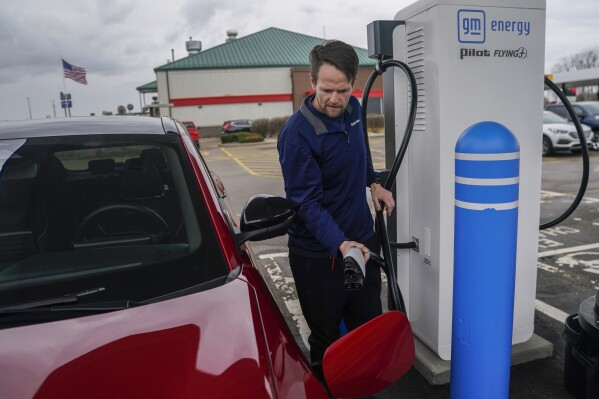In 2024, urban mobility is undergoing a transformative shift, with electric vehicles (EVs) playing a pivotal role in reshaping our cities. A staggering 60% of the world’s population is projected to live in urban areas by 2030, making sustainable transportation a critical priority. Enter President Biden’s ambitious EV Infrastructure Plan, which is set to revolutionize the way we navigate our urban landscapes. By investing in a robust network of EV charging stations across the United States, the plan promises to make EVs more accessible and practical than ever before. In this article, we’ll explore how this infrastructure plan is driving urban mobility, the advancements in EV technology, and practical tips for consumers looking to make the switch to electric.
The Backbone of Urban Mobility: Biden’s EV Infrastructure Plan
Expanding the Charging Network: More Stations, Less Range Anxiety
The cornerstone of Biden’s EV Infrastructure Plan is the expansion of the national charging network. With a target to install 500,000 new charging stations by 2030, the plan aims to alleviate range anxiety—a common concern among potential EV buyers. According to InsideEVs, the U.S. currently hosts approximately 100,000 charging ports, a number expected to quintuple under this initiative. This expansion will not only support the growing fleet of EVs but also enhance convenience for city dwellers who rely on urban mobility.
- Level 2 Chargers: Ideal for residential use, providing a full charge overnight.
- DC Fast Chargers: Perfect for quick top-ups during the day, reducing charging time to as little as 30 minutes.
Investment in Urban Areas: Charging Stations Where They’re Needed Most
Urban centers are at the heart of this infrastructure plan, with a focus on installing charging stations in high-density areas. According to Bloomberg Green, cities like New York, Los Angeles, and Chicago will see the most significant increases in charging infrastructure, addressing the needs of millions of urban commuters. This strategic placement not only supports daily commuters but also encourages businesses to adopt EV fleets, further greening urban transport.
Advancements in Battery Technology: Faster, Longer, Better
New Battery Innovations: The Key to Efficient Urban Mobility
Battery technology is advancing at a remarkable pace, with innovations promising longer ranges and faster charging times. As reported by Battery University, solid-state batteries are expected to hit the market by 2025, offering higher energy densities and quicker charging cycles compared to conventional lithium-ion batteries. This technological leap will make EVs more appealing for urban drivers who demand efficiency and reliability.
- Solid-State Batteries: Predicted to offer 2-3 times the range of current batteries.
- Fast-Charging Capabilities: Reducing downtime, crucial for urban dwellers with busy schedules.
The Role of Renewable Energy: Charging EVs Sustainably
The synergy between EVs and renewable energy is a key component of sustainable urban mobility. According to the International Energy Agency (IEA), integrating solar and wind power into the EV charging network can significantly reduce greenhouse gas emissions. Urban areas are increasingly adopting renewable-powered charging stations, making it easier for consumers to charge their EVs sustainably.
Practical Tips for Adopting EVs in Urban Areas
How to Charge Your EV: Tips for City Dwellers
Charging your EV in a bustling urban environment might seem daunting, but with the right strategies, it’s straightforward:
- Plan Ahead: Identify nearby charging stations using apps like PlugShare or ChargePoint.
- Home Charging: Install a Level 2 charger at home for overnight charging if you have parking facilities.
- Public Charging: Utilize workplace charging stations or public DC fast chargers for quick top-ups during the day.
Where to Buy: Navigating the Urban EV Market
With an increasing number of EV models entering the market, finding the right one can be overwhelming. Here’s a quick guide:
- Research Models: Brands like Tesla, Rivian, and Hyundai offer a range of models suitable for urban driving.
- Test Drive: Visit local dealerships to test drive different models and assess their suitability for city commutes.
- Incentives: Take advantage of federal and state incentives that can significantly reduce the purchase price of EVs.
Comparing EVs: What to Look For
When comparing EVs for urban use, consider the following factors:
- Range: Ensure the vehicle meets your daily travel needs.
- Size and Maneuverability: Compact models are ideal for navigating urban streets and parking.
- Technology Features: Look for models with advanced driver-assistance systems for safer city driving.
Conclusion: Steering Towards a Sustainable Urban Future
Biden’s EV Infrastructure Plan is more than just a policy—it’s a catalyst for change in urban mobility. By expanding the charging network, promoting battery innovation, and integrating renewable energy, the plan paves the way for a cleaner, more efficient urban transport system. As cities continue to grow, the shift towards electric vehicles will not only reduce emissions but also enhance the quality of urban life. Are you ready to make the switch to an EV and be part of this sustainable revolution? Join the movement today and drive towards a greener future. The road ahead is electric, and it’s time to plug into the future of urban mobility.

